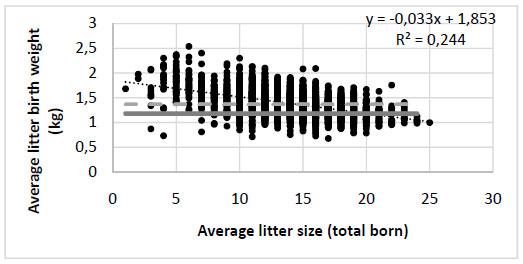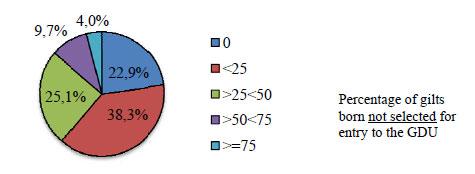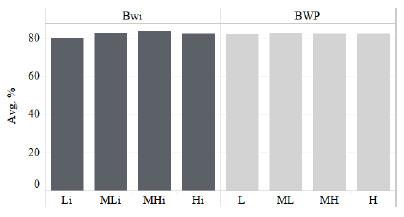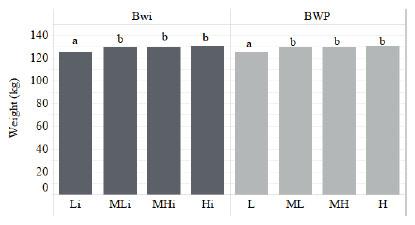Introduction
Despite the wealth of information on the many factors that affect sexual maturation and the early breeding performance of gilts, it has been difficult to establish the needed protocols that produce a consistent supply of “good quality” replacement females. In the context of the latest genotypes available to the production industry, it is important to keep addressing the changing biology of the nucleus sows from which replacement gilts are generated. The phenotypes of some of the emerging sub-populations of contemporary sows prompted a discussion about how these phenotypes might affect the efficiency of replacement gilt production and the performance of replacement gilts at the commercial level of production. Therefore, as our contribution to the present Workshop, we would like to discuss the results from a recent large-scale project that provide insights into the link between birth weight phenotype (BWP) and 1) potential inefficiencies in replacement gilt production at production nucleus level, and 2) variable sow lifetime productivity (SLP) at the commercial level of production.
A key feature of these BWPs is that they need to be measured and then managed at the level of the individual gilt or nucleus sow. This is primarily because the “preferred” BWPs are not reflected in the commercial breeding value (genotype) of production nucleus sows from which replacement gilts are derived. Indeed, some of these phenotypes result from interactions among component growth and reproductive traits that cannot even be measured in the live animal. However, the resulting range of “reproductive” phenotypes produced by these interactions can have very different impacts on SLP, measured as either the number of replacement gilts produced per nucleus sow lifetime, or the lifetime production of quality weaned pigs at commercial level. By understanding the origin of these phenotypes and the underlying physiological traits involved, it is possible to propose management strategies to optimize genetic transfer in integrated production systems. In many ways, the possibility that detrimental sow phenotypes can be identified that are not reflected in the estimated breeding value ascribed is similar to earlier discussions around relative boar fertility and impacts on the efficiency of genetic transfer using artificial insemination (Foxcroft et al., 2008).
Birth traits that determining the efficiency of replacement gilt production
The ability to predict a sow’s litter birth weight phenotype (BWP) is important and has considerable ramifications for the efficiency of replacement gilt production and the lifetime productivity of gilts produced. Identifying sows that repeatedly display the low BWP would allow producers to selectively apply the relevant management interventions at farrowing that would increase early post-natal survival. In the most extreme low BWP population (bottom 15%) at production herd level, Smit et al. (2013) reported that no sow first giving birth to a low birth weight litter produced a high birth weight litter at any subsequent farrowing. Based on the concept that “Measuring and managing sow (litter) birth weight phenotype (BWP)at production nucleus/multiplication level would improve the efficiency of replacement gilt production, and hence genetic transfer to production level” a large scale collaborative research project was developed and involved a four-year analysis of 1) sow, litter and individual gilt BWP at the production nucleus level, and 2) impacts on the down-stream retention of gilts to the Pre-selection and Selection stages of development in a large production system in the USA. Later parts of the study not discussed here, also looked at the effect of “litter of origin” on retention and SLP of replacement gilts once bred.
When considered on the basis of individual pig birthweight, the critical cut-off for mortality in replacement gilts at 4 days of age was 1.18 kg and is similar to that reported previously. Gilts weighing less than 1.0 kg at birth had increased pre-weaning morality rates and little chance of surviving until weaning (Magnabosco et al., 2015). Those gilts that do survive past the nursery phase have poor growth until finishing and are significantly lighter than their higher birth weight littermates. Additionally, as future replacement females, low birth weights negatively impact their reproductive potential. Variation in gilt birth weight was negatively correlated to ovarian and uterine development (Deligeorgis et al., 1984), and Flowers (2015) suggested that below a minimum birth weight of 1.1 kg gilts simply do not have the reproductive machinery to be efficient reproductively, no matter how well they are managed later in life. Magnabosco et al. (2016) reported that gilts weighing less than 1.0 kg at birth, and still selected as replacements at 170 days of age, produced fewer pigs over three parities and remained in the herd for less time. Furthermore, Almeida et al. (2014) reported that although low birthweight gilts were at risk for non-selection at breeding, there was no effect of birth weight on age at puberty.
A “low litter birth weight” carries all the same risks described above for individual low birth weight. In agreement with Smit et al. (2013), a negative relationship between total born (litter size) and litter average birth weight (average of all pigs in the litter) was reported in the current study. More importantly for the proposed approach to improving the efficiency of replacement gilt production, some 15% of sows can be identified within breeding herd populations that exhibit an extreme “low” average litter BWP over consecutive parities, irrespective of the total number of pigs born. Smit (2013) reported that sows giving birth to a low BW litter, again give birth to a low BW litter, or at best medium BW litter at the next farrowing, and that the correlation coefficient to determine the repeatability of average litter birth weight across successive parities is reasonably high (r=0.49 in later parities).
Overall, the individual BW of pigs born (n = 45,523) over 1 - 7 parities (n = 3,244 litters) were used to determine the BWP of multiplication sows (n = 644; PIC) producing Camborough replacement gilts (n=7644) (Table 1).
Across all litter sizes born, there was a negative relationship between litter size (total pigs born) and average litter birth weight (y = - 0.033x + 1.84; R2 = 0.24; P< 0.0001), representing a 600 g difference between the smallest and largest litters (Figure 1). In contrast, the variation in litter average birth weight among litters with the same total born was greater (mean = 1200 g, range 900 to 1500 g). As litter size increases, there is an increasing lack of high birth weight litters due to increased prolificacy.
Table 1. Summary statistics of measured traits of the birth sow used to determine phenotypic classifications.
As shown in Figure 1, the litter average birth weights of the most prolific sows with more than 20 total pigs born are lower than the population average litter birth weight of 1.37 kg. In contrast, across the entire range of litter sizes from 10 to more than 20 pigs total born, there is a population of sows that have low birth weight litters that cannot be attributed to prolificacy in the sense of total pigs born.
Figure 1. Relationship between litter size (as total number of pigs born) and litter average birth weight. The average litter birth weight over the population is 1.37 kg (dashed grey line). The solid grey line shows the critical breakpoint in individual birth weight (1.18 kg) for mortality at d4 after birth.
Sow BWP was determined over at least two successive parities with litters with > 10 total born for sows (n = 644), with an overall mean litter birth weight of 1.35 ± 0.16 kg: these sows then produced some 7,664 replacement gilts that were individually tagged at birth. Overall, the Low (L) and High (H) BWP sows represent 13.4 and 14.6%, respectively, of overall population (Table 2).
Table 2. Summary statistics of measured traits in low (L), medium-low (ML), medium-high (MH) and high (H) birtweight phenotype sows.

Retention rates. A preliminary analysis to determine selection outcomes for pure-bred L3 replacement gilts within the production nucleus flow identifies large variations in the proportion of gilts selected from particular litters (Figure 2). Sectors of the pie-chart show the percentage of total litters in which varying proportions of gilts born were not selected for transfer to the nucleus farm GDU. In about 10% of all litters, between 50 and 75% of gilts born (purple sector) were not selected. An even more extreme outcome was seen in 4% of the litters (light blue sector), with more than 75% of all gilts born being considered "non-select". Using existing selection criteria, a large proportion of gilts were considered "non-select" at weaning or around 140 days of age on the basis of relatively poor growth performance. Combined with the higher proportion of low birthweight pigs that die in the early post-natal period, our prediction (which was confirmed in commercial replacement gilts) is that these high proportions of dead and non-select gilts are born to sows with a repeatable low birth weight phenotype.
Figure 2. Preliminary analysis of selection outcomes for pure-bred replacement L3 gilts identifies large variations in the proportion of gilts selected from particular litters.
Overall, the data on birth weight phenotype collected was the critical first step in linking gilt litter of origin (sow BWP) to the efficiency of gilt replacement production, gilt survival to weaning, retention though the pre-selection stages of gilt development, and final selection in the GDU. Gilt retention rates at various stages of reproduction classified by the different BWPs are shown in Figure 3. As would be expected, relating retention rates to individual birth weight class resulted in greater variation in the retention rates than the sow BTW. However, even when analysed on the basis of the sow's established BWP, the trends very similar. Gilts born to sows with the low BWP have compromised retention all stages of production compared to gilts born to sows with higher BWPs.
Low birth weight determined either on an individual pig basis, as the mean birth weight of the birth litter, or sow's average litter birth weight phenotype is negative for pre-selection rate. Significant differences in survival are already present by day 4 and at weaning, reflecting the early crushing and poorer pre-weaning survival of low birth weight pigs and litters already seen at the commercial level of production (Smit et al., 2013). Also consistent with the present results, Magnabosco et al. (2015) reported that gilts weighing less than 1.0 kg at birth have increased pre-weaning morality and little chance of surviving until and those gilts that do survive past the nursery phase have poor growth until finishing and are significantly lighter than their higher birth weight littermates. As a disproportionate number of low birth weight gilts are born to sows with the low and medium-low BWP, removing 10 to 15% of nucleus sows with the extreme low BWP would improve gilt retention rates in the remaining sows. Additionally, removal of the few very low birthweight gilts born to sows with the higher BWPs would further improve the retention of gilts through the Pre-selection and Selection stages of production. In terms of minimizing lifetime nucleus sow's costs per replacement gilt produced, an early culling strategy for sows determined to exhibit the extreme low BWP seems justified. If culling was based on litter birth weight data from the first two farrowings, even pure-bred nucleus replacement gilts could be removed as potential replacements at the Pre-selection 2 stages at around 170 days of age, at which time their birth dams would already have produced a second litter.
Figure 3. The effect of individual gilt birth weight (Bwi) and sow birth weight phenotype (BWP) on retention rate (%) from birth to “Pre-selection” at 170 d. Retention rates for the extreme High (H) and Low (L) phenotypes are shown.
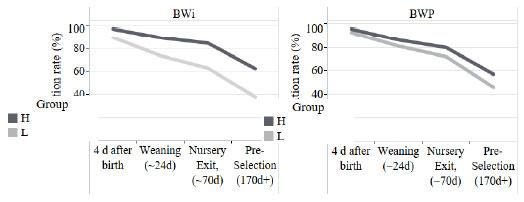
From a genetic transfer perspective, the production of very few replacement gilts in the productive lifetime of some sows in the production nucleus/multiplication herd, represents a poor genetic investment. These sows only “earn” their genetic premium if their genetic potential is effectively passed on to the Camborough replacement gilts used for terminal line production. The disconnect between a high genetic merit for genetic traits included in the estimation of EBV and the production of few replacement gilts carrying these genes to the level of terminal line production, is analogous to the problem of high EBV boars that are determined to have relatively low fertility when used for AI, either in single-sire matings, or when used in pooled semen doses out of which the poorer boars sire very few progeny. In the larger production enterprise that manage their own boars’ studs and production nucleus/multiplication farms, the opportunity to optimize genetic transfer down to the level of terminal line production offers significant economic benefits. In both cases, the additional replacement costs of early culling of unproductive boars and sows is very largely offset by the enhanced performance of the boars and nucleus sows remaining in production.
Growth performance. The associations among the different birth weight classifications and gilt weights at Pre-Selection at 170 days of age are shown in Figure 4. Determined on an individual pig and birth litter weight basis, birth weight had a highly significant effect on weights at 170 days and comparable trends were seen when sow BWP was used in these comparisons. The first and expected conclusion is that birth weight reflects post-natal growth potential, again reflecting results from studies at the terminal-line level of production (Smit et al., 2013) and in comparable replacement gilt studies (Amaral Filho et al., 2010, Magnabosco et al., 2015).
Figure 4. The effect of individual birth weight (Bwi) and sow birth weight phenotype (BWP) on gilt weight at Preselection at 170 days of age. a.b,c.d Differences between columns within birth weight category are significantly different (P < 0.05).
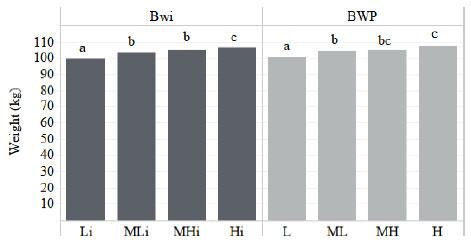
However, in all the birth weight classifications, gilts had adequate growth for achieving sexual maturity in response to stimulation with boars at the final Selection stage of gilt development. The study of Beltranena et al. (1991) defined a threshold growth rate to puberty of 0.55 kg/day below which the attainment of puberty was delayed. As with most recent surveys of gilt growth performance in systems that use feeding to appetite throughout gilt development, the data in Figure 4 suggest that even the low birth weight gilts that are retained to the Pre-select 2 stage of development have sufficient growth performance to express their inherent sexual precocity. Therefore, little relationship would be expected between growth rate classification and the measured responses to stimulation with boars in the GDU/BEAR facilities. If the latter assumption is true, and the post-breeding performance of low BWP progeny is not compromised, this raises questions about existing selection strategies that do not favor the retention of gilts with relatively low growth performance amongst their birth cohort. However, taking into account the cost of feed, non-productive days, born alive and litter uniformity, starting at breeding, Amaral Filha et al. (2010) recommended that gilts should achieve growth rates between 600 and 770 g/d for optimal performance. Again, most gilts at the Pre-select stage in the present study would meet these growth requirements.
At the other end of the growth rate spectrum, the excellent growth performance of gilts born to high BWP sows may be an increasing problem for the industry, as individual gilts are achieving growth rates to puberty of > 0.7 kg/day. As there is no expected link between high growth rates and age at first estrus, some later maturing gilts achieve weights at HNS and at breeding that are above industry benchmarks. If the efficiency of inducing pubertal estrus is low, or the pre-stimulation management or health status of replacement gilts at the time of final selection is poor, over-weight gilts at breeding becomes a major risk factor for gilt retention in the breeding herd (Amaral Filha et al., 2010).
Responses to puberty induction in the GDU: The associations among birth weight classifications and responses to boar stimuli in the purpose built GDU/BEAR facilities used in the trial are shown in Figure 5. Collectively, the data confirms that for those gilts retained beyond the Pre-select 2 stage and moved to the GDU for stimulation with boars, there was little relationship between individual gilt birth weight or sow BWP and age at puberty, having commenced stimulation with boars at around 182 days of age. However, because birth weight was positively associated with growth rate, there was also a positive association with weight at pubertal estrus, approaching a 10 kg difference in pubertal weight between gilts born to the low and high BWP sows (Figure 6).
The 80-83% response rate of gilts with a recorded first estrus (HNS) puberty within 35 d of initial boar exposure in the BEAR systems indicates effective use of the stimulation protocols. Although the on-farm GDU/BEAR systems can lapse into an almost continuous-flow style of management, early identification of a pubertal heat and early culling decisions for non-select gilts are essential if a gradual increase in entry-to-service intervals and overcrowding of GDU pens are to be avoided. As with the off-site GDU/BEAR sites that were part of this study, management of all GDUs on an all-in/all-out basis is important for maintaining breeding herd efficiency.
Figure 5. The effect of individual birth weight (Bwi) and sow birth weight phenotype (BWP) on the percentage of gilts with a recorded heat-no-serve within 35d of boar exposure.
Figure 6. The effect of individual birth weight (Bwi) and sow birth weight phenotype (BWP) on weight at Selection after starting the selection program at around 180 days of age. a.b,c Differences between columns within category are significantly different (P < 0.05).
Conclusions
Poor survival to weaning, and lower gilt retention rates during development, are critical issues for low birth weight gilts and for gilts born to sows with a low BWP. Retaining sows in the production genetic nucleus population if they exhibit a repeatable low BWP negatively impacts the efficiency of replacement gilt production and represents a poor return on the investment in their high genetic merit. Nucleus sow culling strategies aimed at the early removal of the 10 to 15% of sows with the extreme low BWP, as well as non-selection at birth of the lower birth weight gilts from other litters, will improve the overall efficiency of the nucleus/multiplication farm in terms of efficient genetic transfer.
For pre-select gilts entering the GDU stage of production using current pre-selection criteria, lifetime growth performance and litter of origin traits have little impact on breeding performance. However, gilts born to the higher BWP sows were heavier at breeding and their retention in the breeding herd would be considered as a risk factor for SLP. The risk of gilts being too heavy at breeding, with negative impacts on subsequent retention in the breeding herd, emphasizes the importance of efficient GDU/BEAR programs that minimize entry to service intervals. The present study demonstrated that such programs can be implemented in large commercial systems and the success of these selection and pre-breeding programs makes a fundamental contribution to achieving acceptable SLP.
Published in the proceedings of the International Pig Veterinary Society Congress – IPVS2020. For information on the event, past and future editions, check out https://ipvs2022.com/en. 
